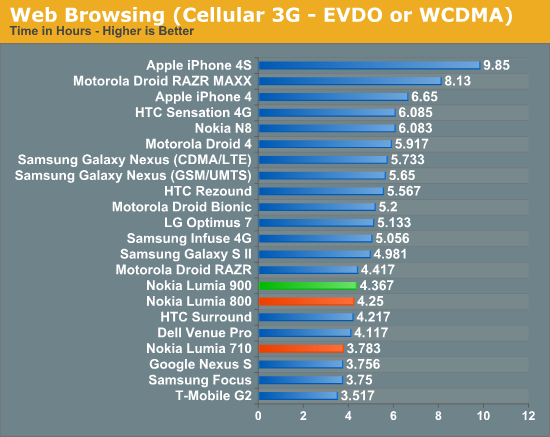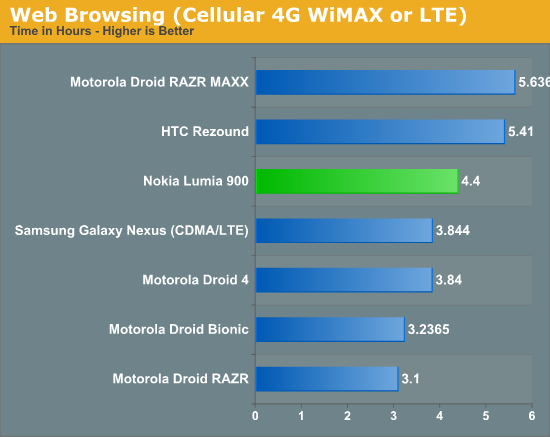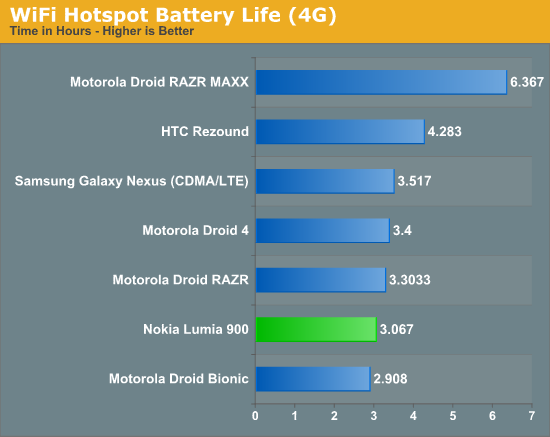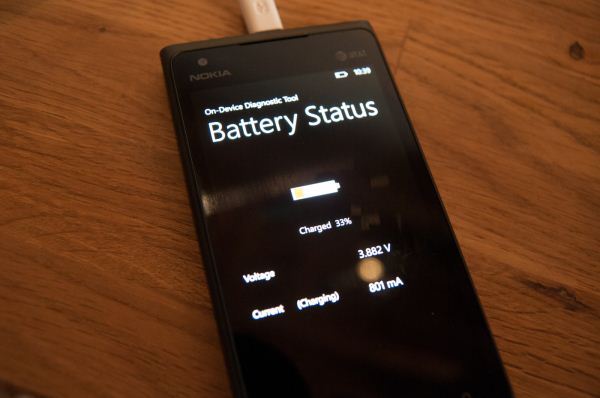Nokia Lumia 900 Review - Windows Phone with LTE
by Brian Klug on April 3, 2012 9:00 PM ESTBattery Life and Charging
First things first, the Lumia 900 has none of the charging issues or problem behavior that initially plagued the Lumia 800. In the course of our battery life testing, I’ve repeatedly discharged and charged the phone completely and the Lumia 900 charges up from completely empty like a champ. It seems those initial growing pains are now squarely behind Nokia.
In addition, Nokia has gone with a compact 5W charger (5V 1A) that the Lumia 900 takes full advantage of during a charge cycle - I repeatedly saw the Lumia 900 draw over 800 mA during the charge cycle in its diagnostics menu, which is awesome. One of the things I’ve seen requested a lot is also measurement of just how long devices take to charge from completely empty - I measured the Lumia at almost exactly 3 hours with repeatability, using the supplied charger. The Lumia 900 uses an internal 1830 mAh, 6.77 Whr battery which is about what you’d expect for a device which includes a 4.3" SAMOLED display and LTE.
So how does battery life fare on the Lumia 900? To find out, I turned to our regular suite of battery life tests which consist of pages loaded endlessly until the phone dies, with the display set as close to 200 nits as possible. In the case of the Lumia 900, this actually ends up being the max brightness setting (WP7 offers three settings and auto). Due to time constraints, I haven’t run the WiFi page loading test, but have run the cellular tests over both 3G WCDMA and 4G LTE.



When it comes to web browsing, both the 3G WCDMA and 4G LTE results end up being pretty close at around 4.4 hours. This tells me that we’re pretty much dominated by the display’s power drain in that neighborhood. The web browsing tests tend to be pretty brutal on AMOLED devices to begin with, partly because we’re dealing with black text atop a white background. In practice I feel like the Lumia 900 does subjectively a lot better than these results really would lend you to believe. If you can believe it, we actually haven't formally published any AT&T LTE device results yet, so the Lumia 900 is our first.
In addition I’ve also run our hotspot tethering test on 3G WCDMA and 4G LTE, which consists of four tabs of our normal webpage loading suite alongside a 128 kbps MP3 internet radio stream all loaded on one wireless client.


The results of the tethering test demonstrate just how taxing constant connectivity can be for the current crop of 45nm basebands, and the Lumia 900 does pay the price for having a relatively hungry one. Our testing was done in good AT&T LTE and HSPA+ coverage, and interestingly enough the results are pretty close for the two air interfaces at around 3 hours. Jumping onto LTE and running the same test incurs a half hour hit.











128 Comments
View All Comments
tipoo - Wednesday, April 4, 2012 - link
It seems to me like Microsoft is deliberately capping WP7 phones so that Apollo phones will look even better by comparison, with the SoC single core limitations and screen resolution caps. I wonder if this phone or other WP7 phones will be able to get WP8 then, or if that will only be on dual core phones?melgross - Wednesday, April 4, 2012 - link
The OS can't handle multi cores or a higher Rez. That's just the way it is. Since that's going to limit sales, why would they deliberately want to do that?Yes, there's a fork of CE (which is what WP7 uses), which allows dual cores, but it has it's own problems as a phone OS.
tipoo - Wednesday, April 4, 2012 - link
But I'm still wondering if current phones will be able to get WP8. Since it has a new kernel, my guess would be no.N4g4rok - Wednesday, April 4, 2012 - link
It's possible, but my not be a profitable. There's always that ugly little trade off between going next generation or supporting legacy hardware.I think what they do with it will depend on how different the OS itself is in terms of features and UI. If it brings an entirely new suite of capabilities that would not be as efficient on single-core platforms, then it might not hurt to let the previous generation to go to pasture. Otherwise, they might loose that regard as an efficient handset.
Then again, who knows if the kernel in Apollo will be built with the intension to utilize dual core hardware, or if the upgraded hardware will be mainly for drawing attention from developers.
Braumin - Wednesday, April 4, 2012 - link
I don't think the kernel will matter. The new kernel will support far more hardware than the old one.When you upgrade your PC from Windows XP to Windows 7, the kernel changes, but the hardware doesn't.
I assume that since basically there are only a couple of different hardware specs for WP7, they will make it possible. The question of course is whether the hardware vendor will bother with the upgrade. In most cases, I would say no, but I also think Nokia will be the exception.
We'll see in the fall though!
ol1bit - Wednesday, April 4, 2012 - link
Yea, Microsoft is way behind in the phone game. They need to keep up, how long have they been play with WP7 now, and still no high rez or multi-core?I think MS continues to make bad decisions. Who wanted a single threaded OS 3 years ago? They just looked at Apple current and said we like that, and lets design ours just like that.
Goggle looks to the future and started Android out multi-threaded. I hope Alppol isn't a hack job with fake multi-threading added in.
robco - Wednesday, April 4, 2012 - link
The $99 price point is interesting, same as the iPhone 4, but with more storage and LTE. I suppose that works since they're still behind the 4S a bit.I like WP7 and if I decide to ditch iOS, it would be my next choice. I just hope MS will support more chipsets and higher display resolutions sooner rather than later. Of course the big issue for me, and others in this area, is the carrier issue in the US. I won't go back to AT&T. For many people the reception is fine and the service tolerable, but not where I live. So far the only WP7 handsets on Sprint or VZW are even more dated.
MS has a lot of ground to gain, but it's not as if they don't have the resources to throw at it...
NeoteriX - Wednesday, April 4, 2012 - link
Brian,Your insight into the display, and in particular, digging up the optical path of the ClearBlack technology, may be overlooked by many. But it's really something where your obvious optics education/background gives you and AnandTech significant added value over the droves of blathering nontechnical review sites and blogs.
Kudos.
EddyKilowatt - Wednesday, April 4, 2012 - link
If this is the kudos section, let me award one too, for posting and discussing the MediaInfo screencap showing the video and audio codec settings. That too is the kind of non-blathering, solid tech info that I'm glad you guys specialize in.(I actually googled "lumia 900 video bitrate"... and must confess I grinned a knowing grin when I saw AnandTech pop up in the first screen of hits.)
name99 - Wednesday, April 4, 2012 - link
"Interestingly enough Nokia does note the presence of Rx diversity for WCDMA on the Lumia 900 front and center, both under their “design” tab and under Data Network on the specifications page. It’s awesome to see another handset vendor realize that great cellular performance is noteworthy"I'm rather more cynical than you. Note that they do NOT support HSPA MIMO.
My guess is that at least part of talking up their diversity antenna is specifically to deflect from that --- throw out some techno-lingo about how we have multiple antennas to "maximize RF performance" and hope no-one notices some conspicuous holes in our HSPA features.